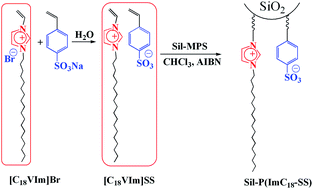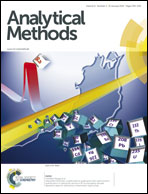Anionic and cationic copolymerized ionic liquid-grafted silica as a multifunctional stationary phase for reversed-phase chromatography†
Abstract
Recently, we briefly reported a new method to prepare ionic liquid-modified silica via copolymerization of anionic and cationic monomer couples on mercaptyl-modified silica, which aimed to enhance the stability of the column during the use of buffer as a solvent. In this paper, the previously prepared copolymerized ionic liquid-grafted silica denoted Sil-P(ImC18-SS) was characterized via elemental analysis, thermogravimetric analysis, and diffuse reflectance infrared Fourier transform spectroscopy. The reversed-phase chromatographic properties were determined particularly by separation of Tanaka test mixture, polycyclic aromatic hydrocarbons and their isomers, disubstituted benzenes, flavonoids, bases and nucleosides. Compared with the conventional ODS column, Sil-P(ImC18-SS) exhibited enhanced shape selectivity for polycyclic aromatic hydrocarbons and better performance for the separation of some polar analytes such as bases and flavonoids. Moreover, compared with previously reported ionic liquid-modified silica stationary phases, the anionic and cationic copolymerized stationary phase offers the advantage of increased stability given that the anions and cations of the ionic liquids were concomitantly immobilized on the silica.


 Please wait while we load your content...
Please wait while we load your content...